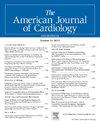复杂先天性心脏病所致严重扩张性右心房难治性房性心动过速的治疗:导管消融以外的临床观点。
IF 2.1
3区 医学
Q2 CARDIAC & CARDIOVASCULAR SYSTEMS
引用次数: 0
摘要
背景:难治性房性心动过速常发生在右心房明显增大的先天性心脏病(CHD)患者中。目的:探讨复杂冠心病合并巨大类风湿关节炎(≥190 mL)患者的心律失常发生机制及综合治疗效果。方法:对10例行导管消融术(CA)的复杂冠心病合并巨大类风湿性关节炎患者(中位年龄40岁[四分位间距(IQR), 33-52岁])进行评估。结果:CA期间共发现23例速性心律失常,观察到三种不同的电生理机制:房颤并发重入性房性心动过速3例,重入性房性心动过速局限于低压瘢痕区(结论:对于伴有RA明显加重的冠心病患者,单独CA往往是不够的。包括手术干预和基于起搏器的心律控制的联合策略似乎为心律失常管理和血流动力学层提供了更好的结果。本文章由计算机程序翻译,如有差异,请以英文原文为准。
Refractory Atrial Tachyarrhythmias Management in Severely Dilated Right Atrium Due to Complex Congenital Heart Disease: Clinical Perspectives Beyond Catheter Ablation
Refractory atrial tachyarrhythmias frequently occur in patients with congenital heart disease (CHD) who have a markedly enlarged right atrium (RA). The obfective of this study was to elucidate arrhythmogenic substrates and evaluate the comprehensive treatment outcomes in patients with complex CHD and a giant RA (≥190 mL). Ten patients with complex CHD and a giant RA who underwent catheter ablation (CA) were evaluated (median age, 40 [interquartile range (IQR), 33 to 52] years). A total of 23 tachyarrhythmias were identified during CA. Three distinct electrophysiological mechanisms were observed: atrial fibrillation with coexisting reentrant atrial tachycardia in 3 patients, reentrant atrial tachycardia localized to low-voltage scar areas (<0.03 mV) in 2 patients, and atrial tachycardia likely involving epicardial pathways in 3 patients. CA alone achieved an overall success rate of 70%, with partial success in 50% of cases. Post-CA, 6 patients underwent surgical intervention, including RA volume reduction (RAVR) and RA/coronary sinus cryoablation, while 8 patients received pacemaker-based rhythm management. Among the 9 patients treated with either surgical or device-based therapy, the clinical arrhythmia severity score showed significant improvement (median Δ, −3 [IQR, −4.5 to −2], p = 0.004), accompanied by reductions in brain natriuretic peptide levels (median Δ = −39.5 [IQR, −114.7 to −26.0] pg/mL, p = 0.004) and cardiothoracic ratio (Δ = −6.8 [IQR, −11.9 to 0.1]%, p = 0.039). In conlusion, in CHD patients with markedly enlarged RA, CA alone is often insufficient. A combined strategy involving surgical intervention and pacemaker-based rhythm control appears to offer superior outcomes for both arrhythmia management and hemodynamic status.
求助全文
通过发布文献求助,成功后即可免费获取论文全文。
去求助
来源期刊

American Journal of Cardiology
医学-心血管系统
CiteScore
4.00
自引率
3.60%
发文量
698
审稿时长
33 days
期刊介绍:
Published 24 times a year, The American Journal of Cardiology® is an independent journal designed for cardiovascular disease specialists and internists with a subspecialty in cardiology throughout the world. AJC is an independent, scientific, peer-reviewed journal of original articles that focus on the practical, clinical approach to the diagnosis and treatment of cardiovascular disease. AJC has one of the fastest acceptance to publication times in Cardiology. Features report on systemic hypertension, methodology, drugs, pacing, arrhythmia, preventive cardiology, congestive heart failure, valvular heart disease, congenital heart disease, and cardiomyopathy. Also included are editorials, readers'' comments, and symposia.
 求助内容:
求助内容: 应助结果提醒方式:
应助结果提醒方式:


